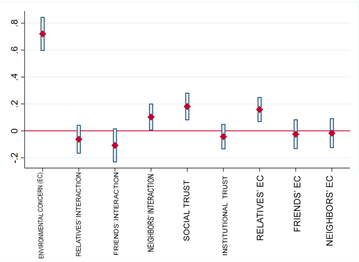Interacting locally, acting globally: trust and proximity in social networks for the development of energy communities
Caferra R., Colasante A., D’Adamo I., Morone A., Morone, P., 2023 – Scientific Reports
The 2019 European Union Clean Energy Package underscored the pivotal role of energy communities and, more broadly, collective self-sufficiency programs in fostering long-term sustainability. The development of energy communities offers environmental, social, and economic benefits; however, they may face challenges such as limited social, institutional, and infrastructural support.
Unlike other measures related to the energy transition, the long-term stability of a community necessitates higher coordination costs, requiring direct citizen participation both individually and collectively. Therefore, understanding both the economic and social stability of an energy community is crucial.
Behavioral research has shown that individual decisions are not solely driven by economic motivations but also by social norms that shape pro-environmental commitment. Thus, even the most economically advantageous policies might falter without genuine interest. The social context significantly impacts cooperation decisions. For instance, peer effects have been identified as key drivers of individual decisions in various fields, including political science, psychology, and urban planning.
In the article “Interacting locally, acting globally: trust and proximity in social networks for the development of energy communities,” published in Scientific Reports, Rocco Caferra, Annarita Colasante, Idiano D’Adamo, Andrea Morone, and Piergiuseppe Morone followed this research vein, applying social capital theories with an emphasis on the nature, quality, and quantity of human interactions as potential determinants of social stability in the formation of energy community, i.e., associations of citizens, organizations and companies that decide, together, to build plants to produce and share renewable energy. They argue that a set of civic norms, trust, and social relationships can drive meaningful socioeconomic progress.
Data were collected through an online survey distributed nationwide between March and April 2023, gathering approximately 300 observations. The importance of social relationships in building energy communities was examined by considering both family and broader social contexts. Information was collected about the frequency of interactions with neighbors, friends, and relatives (structural social capital), and levels of social and institutional trust (relational social capital) were assessed. We also gathered data on the pro-environmental attitudes of different groups (civic norms). The results indicate that the inclination to participate in an energy community is not merely an individual choice dependent on respondents’ pro-environmental attitudes, but it is also a social choice influenced by the quality of relationships with potential project partners (neighbors).
Figure 1 summarizes the effect of the variables introduced in the study through a multiple regression model. In addition to individual pro-environmental attitudes, two main transmission channels emerged. The first refers to the influence of family in defining sustainable paths. The second channel is social in nature: greater social involvement and a higher number of interactions with neighbors increase the propensity to be part of an energy community.
Family influence can define sustainable paths: social norms are primarily learned in the family setting and determine the value of cooperation. The second channel is social in nature: structural social capital facilitates collective action and, given that geographical proximity is a prerequisite for community formation, good interaction with neighbors is crucial for cooperative willingness. Relational social capital is based on the concept of trust, which in turn determines cooperation: in this case, the key role is played by trust in one’s peers.

These data suggest that the quality of social interactions is a crucial factor in forming sustainable energy communities. It is also interesting to note that, unlike other measures, this decentralized solution does not seem to be influenced by the level of trust in political institutions. It appears to be a solution whose sustainability depends greatly on so-called informal institutions (communities, places of active citizen participation), as opposed to formal institutions and governmental stability. Another interesting finding is that the propensity to join an energy community increases with age. This could mean that despite the new generation being dubbed the “green generation,” the lack of participation in an energy community may be linked to the uncertainty that characterizes their working and social lives. The creation of an energy community entails significant initial costs, which could represent a disincentive for those who have not yet decided where to settle long-term. To foster their inclusion in the project, it would therefore be necessary to promote not only environmental policies but also structural policies to encourage socioeconomic stability.
In conclusion, the development of energy communities requires a multifaceted approach that considers technical, economic, social, cultural, and organizational aspects. The high cost of coordination associated with this choice makes it more of a collective decision than an individual one. Along with the right policy tools from central authorities, this type of decentralized initiative requires a broader vision, a “bottom-up push” that starts with citizens, the creation of virtuous and sustainable communities that are willing to organize collectively to secure a stable future for these initiatives. By incorporating these elements, energy communities can effectively contribute to the transition towards a sustainable energy system and promote a more equitable and environmentally aware society. Additionally, it is crucial to note that recent debate in Italy and Europe has shown increasing interest in energy communities as a vital tool for achieving energy sustainability goals.
From a legislative and economic perspective, the Renewable Energy Directive (RED II) has been recently transposed and implemented in Italy with a new decree issued by the Ministry of the Environment and Energy Security, introducing new rewarding incentive mechanisms for the establishment of Renewable Energy Communities for a duration of 20 years. However, to maximize its impact, it is essential that these policies are accompanied by strong public awareness aimed at building a stable and virtuous social fabric, where the civic engagement of citizens enhances the effectiveness of the introduced economic incentives.

